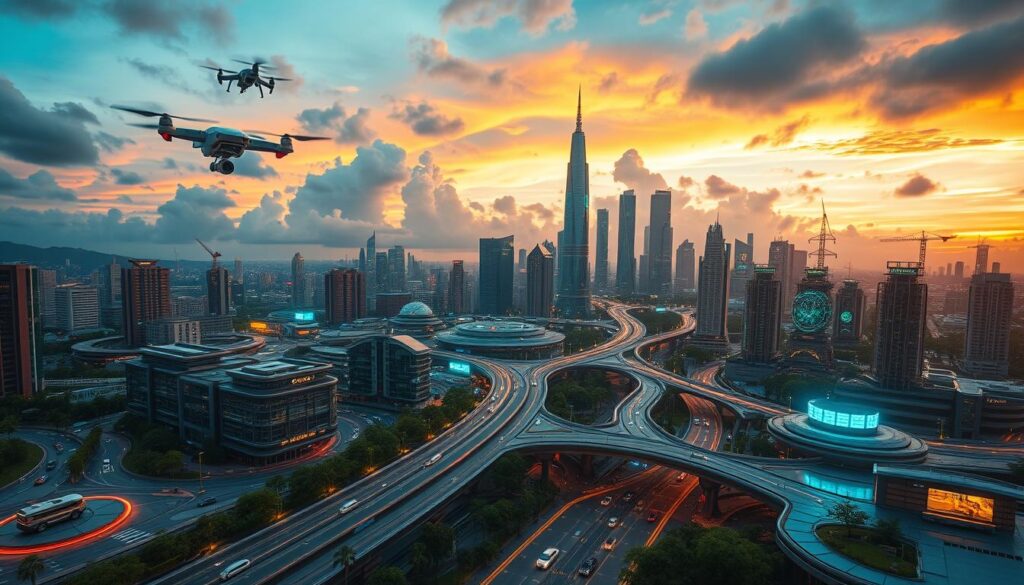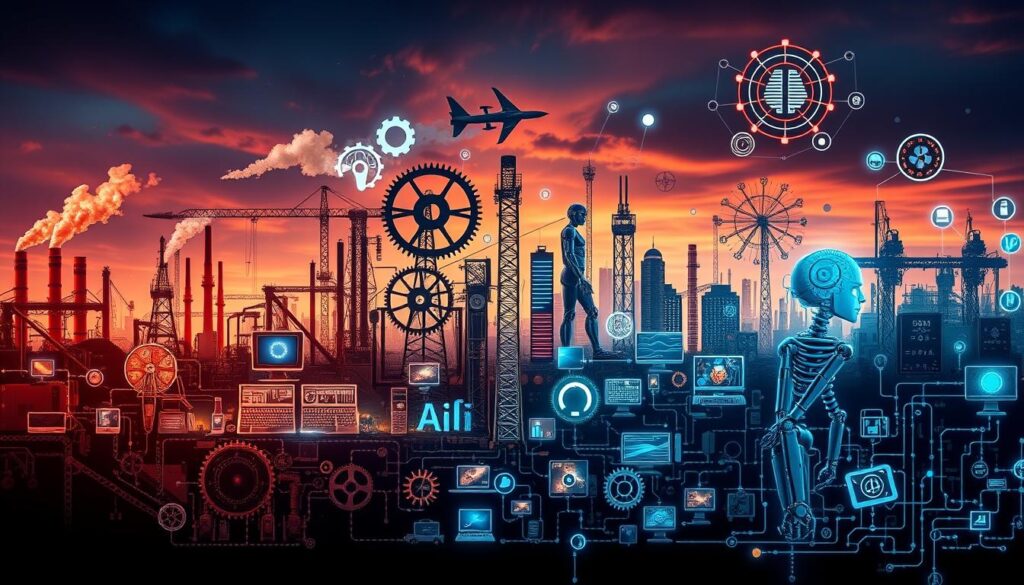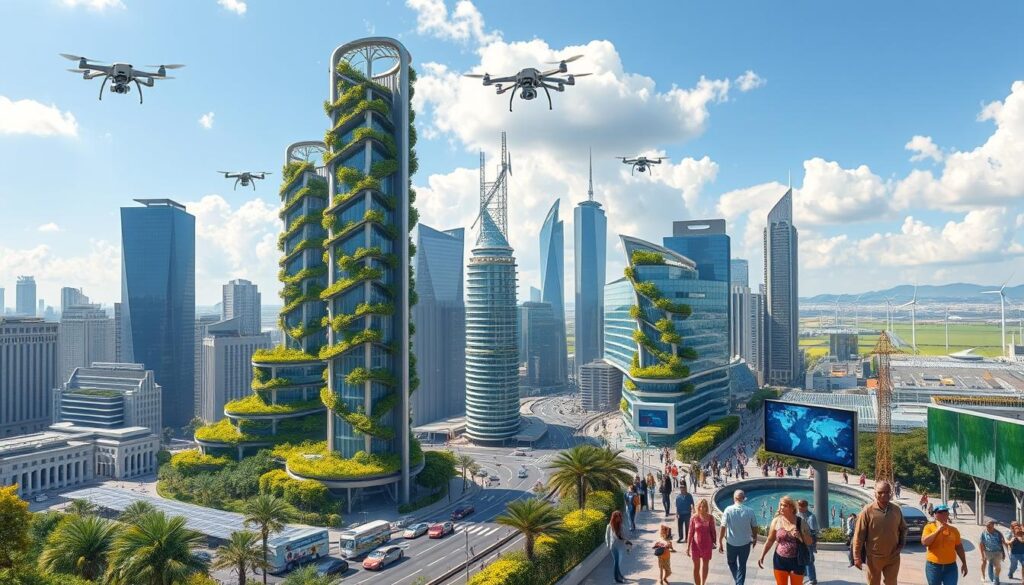
Did you know that the number of Chinese students studying abroad grew from 125,000 in 2002 to 134,000 in 2006? This shows how fast global education and work are changing. It highlights the big impact of new technologies on our world.
The Fourth Industrial Revolution is a big change, not just another tech step. It combines digital, physical, and biological techs, leading to Industry 4.0. This mix is changing industries and societies fast. Innovations like AI, robotics, IoT, and biotech are changing how we live and work.
AI is making things more efficient and creating new ways to do business. The IoT is linking devices and systems, making cities and supply chains smarter. In healthcare, biotech is changing treatments with personalized medicine and gene editing.
But, we must face the challenges these changes bring. We need to think about data privacy, bias in algorithms, and gene editing ethics. We also have to make sure everyone can use technology, closing the digital gap. The Fourth Industrial Revolution needs teamwork and rules that help innovation but also protect us.
For more on how these new techs are shaping our future, check out this article. Let’s explore how Industry 4.0 is changing our world, putting people at the heart of tech and adapting to new job needs.
Key Takeaways
- The Fourth Industrial Revolution integrates digital, physical, and biological technologies.
- Automation and AI are reshaping various sectors, driving efficiency and new business models.
- The IoT connects devices and processes, leading to smarter cities and optimized supply chains.
- Biotechnology advancements like CRISPR are revolutionizing healthcare with personalized medicine.
- Addressing ethical considerations and ensuring equitable access to technology are crucial.
- Regulatory frameworks must balance innovation with rights and security.
- Continuous learning and interdisciplinary collaborations are vital in this new era.
The Evolution of Industrial Revolutions
The history of industrial progress is filled with big changes in technology and society. Each change is called an industrial revolution. These revolutions have greatly changed the world. Let’s explore how technology has evolved through these times.
The First Industrial Revolution
The First Industrial Revolution started around 1765. It moved economies from farming to factories and cities. Coal was key, bringing machines and mass production. This was the first time products were made on a large scale.
This era was a big step in technology. It set the stage for future changes.
The Second Industrial Revolution
The Second Industrial Revolution began in 1870. It brought new technologies like gas, electricity, and oil. The first cars and airplanes were also made during this time.
These inventions changed industries and daily life. They made production faster and bigger.
The Third Industrial Revolution
The Third Industrial Revolution, or Digital Revolution, started in 1969. It combined electronics and information technology. Nuclear energy was also important, especially in Europe and the US.
Computers and automation were key. This era brought us into the digital age. It laid the foundation for today’s technology.
| Industrial Revolution | Key Innovations | Impact |
|---|---|---|
| First Industrial Revolution | Coal, Mechanized manufacturing, Steam engines | Shift from agrarian economies to industrial economies, urbanization |
| Second Industrial Revolution | Electricity, Combustion engines, Steel, Telephones | Mass production, Chemical industry, Enhanced communication and transportation |
| Third Industrial Revolution | Electronics, Computers, Nuclear energy | Digitalization, Automation of processes, Information age |
The history of industrial progress shows human creativity and drive for improvement. As we move into the Fourth Industrial Revolution, knowing about the past helps us understand today’s technology and its effects on our world.
Key Technologies Driving the Fourth Industrial Revolution
The Fourth Industrial Revolution is changing how we interact with technology. Key technologies like AI, robotics, and IoT are leading this change. They are not just improving old systems but are changing how humans and machines work together.
Artificial Intelligence and Machine Learning
AI advancements focus on better data analysis and decision-making. Machines can now make decisions and predict outcomes thanks to AI and machine learning. The digital age has created a lot of data, known as “big data,” for insights and predictions.
Cloud and edge computing help store and process this data quickly and cheaply. Quantum computing could make machines even smarter, offering powers beyond today’s supercomputers.
Robotics and Autonomous Systems
Robotics have evolved to include cobots that work with humans. This makes workplaces more efficient and safe. Now, 53% of companies are investing more in robotics and automation to strengthen their supply chains.
In five years, 76% of companies will use robotics and automation. Autonomous vehicles are also changing transportation, making it safer and more efficient.
Internet of Things (IoT)
IoT is changing how devices talk to each other. There are 20 billion smart devices worldwide, and this number is expected to grow to 200 billion. IoT is making devices more connected, from smart homes to industrial settings.
The new 5G network will make wireless connections faster and more stable. This will connect even more devices and improve data streams, expanding IoT possibilities.
| Technology | Current Usage | Expected Growth |
|---|---|---|
| Smart Devices (IoT) | 20 Billion | 200 Billion |
| Robotics | 53% of companies increasing investment | 76% of companies in 5 years |
| AI and Machine Learning | Decision-making and task execution | Integration with quantum computing |
Impact on Industries and Economies
The Fourth Industrial Revolution is changing the world’s economy. It’s affecting big areas like manufacturing, healthcare, and energy. New tech like AI and IoT is making things more efficient and cheaper.
This change is huge for industries. For example, making things faster could increase by 5 to 15%. In plastics, using energy sensors has cut power use by 40%, saving over $200,000 a year. The US and China are leading in these new technologies.
But, there’s a downside. The gap in income between rich and poor countries is over $40,000. Poor countries need to move into tech sectors to catch up.
Helping these countries is key. Governments should improve internet access and digital skills. They also need to make rules that help new tech grow.
Working together is also important. Sharing knowledge and ideas can help everyone benefit from new tech.
Automation brings big benefits. Countries with the most tech are seeing big gains in making things. The US and China are leading in AI, showing their strength in this area.
| Region | IoT Investment | AI Research Concentration | % AI Start-up Funding |
|---|---|---|---|
| United States | High | 70% | 94% |
| China | High | 70% | 94% |
| European Union | Three-quarters (shared with the US and China) | Lower | Lower |
The changes we’re seeing are all connected. Embracing these changes will shape the future of our economies. It’s a time of great opportunity and challenge.
The Role of Big Data Analytics in Industry 4.0
Industry 4.0 is changing how we make things, thanks to big data analytics. Digital tech and advanced analytics are making factories smarter and more efficient worldwide. Big data helps companies use lots of info from sensors and devices, leading to better decisions.
Big Data in Manufacturing
Big data analytics is helping manufacturers stay ahead. It lets them understand data in real-time, thanks to sensors and devices. For example, smart factories use analytics to find and fix problems without extra cost.
Companies like Intel use real-time data to spot patterns and faults. This saves money and cuts down on downtime. Predictive maintenance is also key, helping factories plan maintenance and avoid unexpected stops.
Enhanced Decision-Making with Data
Big data analytics does more than just improve factories. It helps businesses predict demand and plan better. This way, companies can meet market needs and use resources better, possibly making more money.
Big data also makes work safer and helps workers learn new skills. It’s key to making the most of Industry 4.0. Big data improves supply chains and warehouse work, too. Businesses that don’t use big data risk falling behind. For more on big data in Industry 4.0, check out this link.
FAQ
What is the Fourth Industrial Revolution?
The Fourth Industrial Revolution is a big change. It combines digital, physical, and biological technologies. This changes how industries and societies work. It uses new tech like AI, robotics, and IoT.
How does the Fourth Industrial Revolution differ from the previous ones?
The Fourth Industrial Revolution is different because it mixes advanced digital tech with physical and biological systems. This changes how we live and work.
What are the key technologies driving the Fourth Industrial Revolution?
Key tech includes AI, Machine Learning, Robotics, and IoT. These make things smarter and more efficient. They help with automation and data analysis.
How is AI influencing Industry 4.0?
AI and Machine Learning improve data analysis and decision-making. They help businesses run better and more efficiently. They also make things like maintenance and supply chains better.
What role does IoT play in the Fourth Industrial Revolution?
IoT makes devices talk to each other. This makes operations smoother and more efficient. It helps with real-time monitoring and better asset management.
What industries are most affected by the Fourth Industrial Revolution?
Industries like manufacturing, healthcare, agriculture, and energy are big changes. They use AI and IoT to get better and more efficient.
What are some of the economic impacts of the Fourth Industrial Revolution?
The Fourth Industrial Revolution could bring big economic growth. But, it also means jobs might change. It needs new skills and policies to keep up with tech.
How is Big Data Analytics contributing to Industry 4.0?
Big Data Analytics gives insights for better decisions. In manufacturing, it makes production lines better and reduces waste. It helps shape the future of business.
What are the benefits of using Big Data in manufacturing?
Big Data in manufacturing improves production, cuts waste, and boosts quality. It also predicts when things need fixing. This makes businesses more productive and cost-effective.
How can businesses leverage data for enhanced decision-making in Industry 4.0?
Businesses can use data with advanced analytics for better insights. These insights help make smart decisions. They improve operations and drive growth and innovation.
Future App Studios is an award-winning software development & outsourcing company. Our team of experts is ready to craft the solution your company needs.










